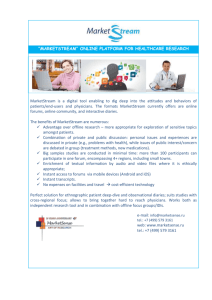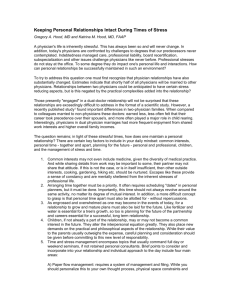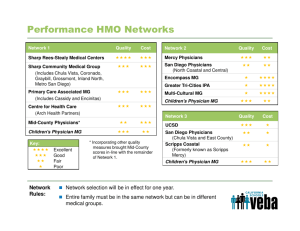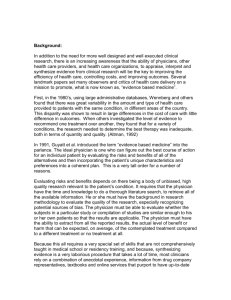Physician Well‐being: Promotion, Maintenance and Monitoring Peter Yellowlees MD UCD Physician Well‐being Committee
advertisement
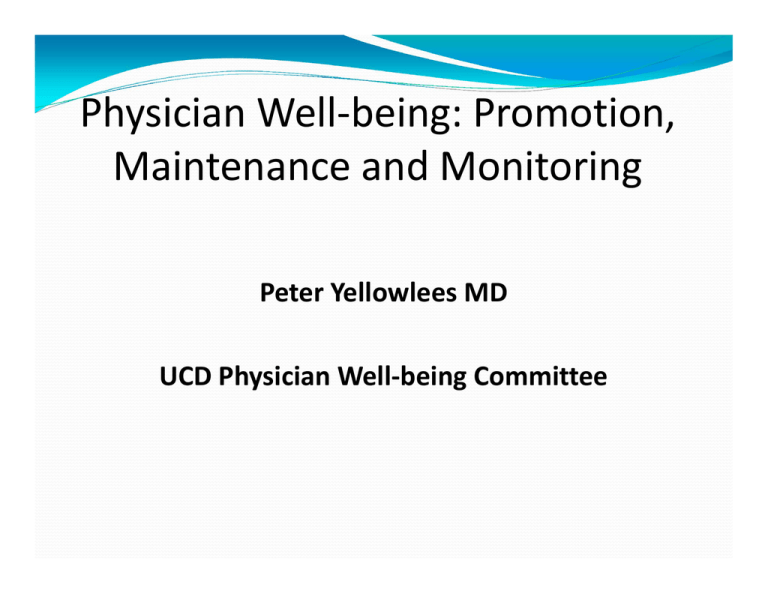
Physician Well‐being: Promotion, Maintenance and Monitoring Peter Yellowlees MD UCD Physician Well‐being Committee Disclaimer PY has no conflicts of interest for this topic to disclose Learning Objectives Learn about physician preventive health approaches to ensure good personal health and continuing fitness to practice. Learn about solutions and treatments for depression and anxiety disorders that commonly affect physicians Be aware that physicians respond well to treatment of anxiety and depression and generally have a good prognosis Understand the role of the UCD Well‐Being Committee Physicians across their lifespan Childhood/adolescence –sublimation, work commitment Young adulthood – profound performance demands, intolerance of failure or even mediocrity, delayed gratification Entry to Medical School – obsessive, self‐directed and nurturing qualities valued Middle adulthood – becoming established, yet lingering debt, deferral of age‐usual activity Old age –resistance of retirement and confrontation of mortality/vulnerability Profession may lead to “excessive identification” “My work is not what I do, it is who I am” “It is a profession, not just a job” “Only another physician can truly understand me” All these positions can lead to delayed gratification and excess social distance, thus lack of intimacy, and increase risk of alc/substance abuse/dependence, anxiety and depression – especially in caring (dependent) and meticulous (compulsive) individuals ‐ personality characteristics we select for in MD’s. The Evolution of the Resident July September November January Duke University Life Curriculum : ERASE Exercise Relaxation Activities Supportive Relationships Emotional Expression Relaxation Deep breathing Muscle relaxation Meditation Imagery/Visualization Mindfulness Yoga/Tai Chi classes Or through exercise, sports and having fun……….. Refresh with Time Outs on long shifts……. Ipod/CD/TV/Email/Internet game or show Power nap Social Interlude: call a friend, call home, grab coffee with fellow resident Walks Library/reading Supportive Relationships and Systems Things people never say on their deathbed………. “I wish I had spent more hours working in the hospital” Make personal relationships the priority you want them to be Keep personal relationships intact – short phone calls can help Reach out to family and friends Form alliances with colleagues Address the “here and now,” not the “there and then” beware of “toxic levels” of gratification delay That which you value is that on which you spend your time – so spend time on relationships Consider counseling, even one session – “a problem shared is a problem halved……..” Emotional Expression Expressing emotions in safe and appropriate way leads to better coping with family, friends, counselor Keep a journal/blog/facebook – but make sure you are careful about privacy issues Humor, jokes, fun and games all allow emotional expression Touch base with seniors and supervisors ISOLATION=POOR OUTCOME Mental illness in MD’s Major depression lifetime prevalence in U.S. male MD’s: 12.8% (general population 12%) Major depression prevalence in women MD’s 19.5% (= general population women) Ethnic differences: Asian female MD’s lower Suicide relative risk: 1.1‐3.4 in male MD’s Suicide relative risk: 2.5‐5.7 in female MD’s Center et al., JAMA 2003; 289: 3161‐3166 Struggling in silence 300‐400 physicians die each year by suicide Methods: OD, firearms Risk factors: depression (90%), alcohol abuse Higher completion/attempt ratio In general population, completed suicides by men = 4 x women In MD’s, completed suicide by men = women American Foundation for Suicide Prevention High risk for suicide MD profile Male or female, white Age: > 45 (female), > 50 (male) Divorced/separated, single, marital disruption Depression, bipolar d/o, anxiety Alcohol, drugs (25% suicides while intoxicated) Workaholic, risk‐taker (high stakes gambler, thrill seeker) Center et al., JAMA 2003; 289: 3161‐3166 High risk for suicide MD profile (cont.) Physical symptoms (chronic pain, debilitating illness) Change in professional status − threat to status, autonomy, security, financial stability, recent losses, increased work demands Narcissistic injury Access to means (legal medications, firearms) Center et al., JAMA 2003; 289: 3161‐3166 Is it the environment? Harvard Study of Adult Development: 47 MD’s Only those with preexisting psychological difficulties evident at college entry had later psychiatric problems No evidence of ↑ occupational stress in MD’s Stressful events thought to precipitate suicide are often a result of the person’s behavior Center et al., JAMA 2003; 289: 3161‐3166 Protective factors Effective treatment for mental/medical illness Family/social support Resilience Coping skills Religious faith Restricted access to lethal means Center et al., JAMA 2003; 289: 3161‐3166 Barriers to MDs seeking care 35% MDs have no regular healthcare provider Discrimination in: Medical licensing Hospital privileges Professional advancement Shift in professional attitudes & institutional policies needed to support MDs seeking help Center et al., JAMA 2003; 289: 3161‐3166 Drugs and physicians Percent 50 45 40 39.5 33.9 35 30 25 20 11.9 Percent 15 10 5 0 3.7 2.8 1.8 1.8 4.6 Drugs and Specialties Psychiatry Neurology Orthopedics Pathology Radiology OB/GYN Family Medicine Surgery ER Anesthesiology 0 5 10 15 20 25 Warning Signs Change in behavior Altered thinking Chronically tired Wanting lots of breaks Takes very long breaks More disheveled A “bad” resident/attending Warning Signs Wanting to do extra work Offering to do extra shifts Offering to cover for colleagues The go‐to person Wanting to work in the OR a lot A “good” resident/attending Work Behavior Differs Depending On Substance If work is source substance; increased isolation, longer hours If source away from work like alcohol: poor work performance, late Mood swings, depression, irritability Why is it Hard to Recognize? Addicted physicians continue to function at high levels for a long time only when performance is markedly impaired Alcohol hard to detect as it is accepted socially and even encouraged Hard to tell misuse from abuse Alcohol use usually detected through complaints of others Routine Drug testing and psychological screening Done on post office workers, pilots, train drivers and others Routine at Shiners' Hospitals, VA Hospitals Voluntary Screening introduced here 2013 Why is Substance Use by Physicians Often Not Identified or Addressed? Physician's Own Denial Unable to recognize they have a problem If they see the problem they make the mistake of assuming they can handle it themselves Physicians do not see themselves as in need of help, they are the ones who help others Physicians see substance use and abuse as a personal and moral failure not as a disease Denial by Family Do not know how to help so they do not voice their concerns Do not know where to turn for help Fear that the physician will destroy his or her career if the problem is addressed and in turn their family will suffer Denial by Peers and Institution Locked into a conspiracy of silence Fear retribution by physician Risk a friendship or working relationship Seen as trouble maker by other colleagues, “do not rock the boat” Collude with physician that they can handle the problem on their own Physician, Family Members, Peers and the Institution Often do not Understand the Potential Resources That Exist to Assist Physicians Which Will Allow them to Continue to Practice Treatment can save a career without the risk of loss of licence Email invitation is sent out encouraging completion of the Wellness Survey. includes link to a secure website which further explains the program and provides an opportunity to take the survey. survey and further information can also be accessed directly through the Medical Staff Well‐Being Committee’s main survey page. After submitting the survey: participants are classified into one of four tiers: 1a, 1b, 2, or 3 counselor reviews answers and prepares personalized responses. all participants are invited to meet in‐person with the program counselor for further discussion and assessment. participants also has the option of using the website’s “dialogue” feature to communicate online with the counselor. During the in‐person meeting: Further evaluation Treatment options are discussed Counseling Psychiatric services Other treatment services Consent for participation in research Consent to participate in research study 13 departments: 107 total faculty and residents completed survey (2 did not disclose position). Of these respondents: 17% fell into the tier 1a category (highest risk category, mentioning suicide in the survey) 16% fell into the tier 1b category (also high risk category, endorsing severe distress) 63% fell into the tier 2 category (mild‐moderate risk category, endorsing mild‐ moderate distress) 5% fell into the tier 3 category (low risk category, denying any distress). Of these, 22% followed up with the counselor through the online dialogue feature. A small set of these participants have come in for an in person assessment and were referred to services. What if a Colleague is Impaired Contact physician directly and discuss resources available: Start from a clinical perspective and state concern regarding resident and patient safety Avoid diagnosis and describe the behavior Offer Phone Numbers and website for Well‐Being Committee In Addition: •Make an anonymous report to Program Director or Chair •Anonymous report to Well‐being Committee Increased Awareness and Access to Treatment is Important as Prognosis is Good!! Recovery rate for physicians who enter treatment and are followed for 5 years is 85‐90% with monitoring Physicians respond better than general population to intervention ED Physicians Substance Abuse 5 year cohort monitoring in 16 states – 56 ED MD’s v 724 other MD’s – findings – Rose et al (in press) : ED MD’s proportionately higher than expected rate of Sub Ab and over‐represented in study 50% Alc, 38% Opiods At 5 years 84% ED MD’s practicing v 80% other MD’s Who Monitors and How? State Drug Diversion Programs for Impaired Physicians Available in all states except California Usually consists of: Attendance at AA/NA Regular drug testing, random Regular therapy Monitor Workplace monitor Who Monitors and How? California Diversion Program sunsetted a few years ago MBC now emphasizes physician wellness and prevention There are reporting laws to the MBC eg a DUI Most physicians in California are on their own Some centers have monitoring programs though their well‐being committee The CMA is trying to set up a state wide program but it will need legislation, first attempt recently failed Where Should Physicians Go for Help? Their own PCP Medical Staff Well‐Being Committee Employee Assistance Program: Academic and Staff Assistance Program (ASAP) Residents‐GME Psychologist Health Insurance and Behavioral Health Plan Moutier, C., Norcross, W., Jong, P., Norman, M., Kirby, B., McGuire, T., Zisook, S. (2012). The suicide prevention and depression awareness program at the university of california, san diego school of medicine. Academic Medicine, 87(3):1‐7. Peter Yellowlees MD Chair UCD Well‐being Committee peter.yellowlees@ucdmc.ucdavis.edu 916 ‐ 734 – 8451 (office) 916 ‐ 833 – 1874 (cell)



